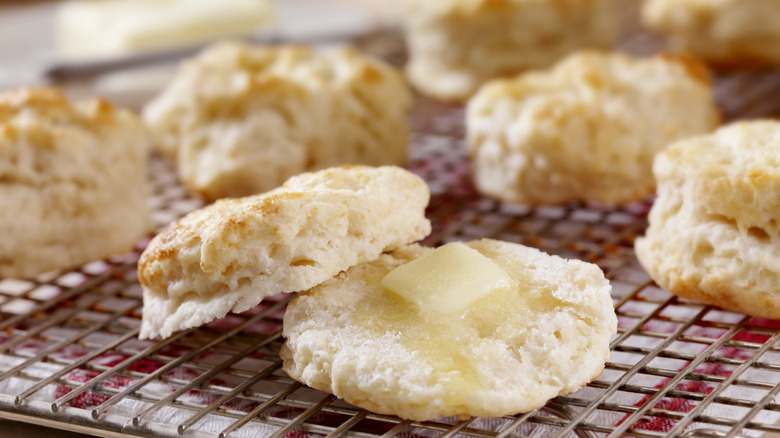Anthony Bourdain's Tedious Butter Technique For Biscuits
There's something almost magical about biting into a perfectly made biscuit. Its light, flaky layers, and rich flavor make for an unparalleled breakfast bread. But to make the best biscuits, Chef Anthony Bourdain, with his penchant for perfection and attention to detail, had some specific instructions about butter. More specifically, he had a series of steps designed to elevate the humble buttermilk biscuit recipe, which he highlighted in his 2016 cookbook, "Appetites: A Cookbook."
According to the recipe, Bourdain's butter directive is summarized in three steps: First, freeze the butter. Next, leave it at room temperature for five minutes before cutting it into cubes. After that, refrigerate the cubed butter before it's incorporated into the dough. It might seem like a lot of fuss over butter, but with a deeper understanding of butter's role in biscuits, the genius of this method becomes evident.
The primary reason behind Bourdain's butter method is temperature; it reflects his deep understanding of culinary techniques and his unwavering commitment to quality. By controlling the state and temperature of the butter at various stages of the biscuit-making process, he ensures every element, from texture to flavor, is impeccable.
Why butter is vital to perfect biscuits
Butter is an emulsion of fat and water. Cold butter, when introduced to a hot oven, releases steam as it melts. While the fat provides that unmistakable rich taste, this steam creates pockets within the dough, leading to those beautiful, flaky layers that make biscuits so delightful. If the butter were warm or even room temperature, it would be absorbed into the dough, and the biscuits would turn out dense rather than airy and flaky.
Freezing and then cubing the butter makes it easier to work into the dough. Smaller pieces of butter ensure even distribution, allowing every bite of the biscuit to have that rich buttery flavor. Additionally, refrigerated butter firms up but isn't as hard as frozen butter, making the cubes just right for mixing into the dough without melting.
Other important factors butter fat contributes to biscuits include the browning of the exterior and the crisp crust. Fat from the butter is also important to the interior tenderness because the fat coats the flour proteins, reducing gluten development. Lesser gluten means softer, more tender biscuits.
So, while a biscuit might seem like a simple baked good, achieving perfection requires knowledge, technique, and a touch of genius. And as Bourdain showed us with his tedious butter instructions, the devil (or in this case, the deliciousness) is in the details.

